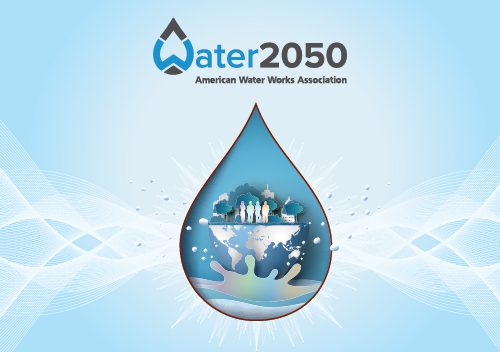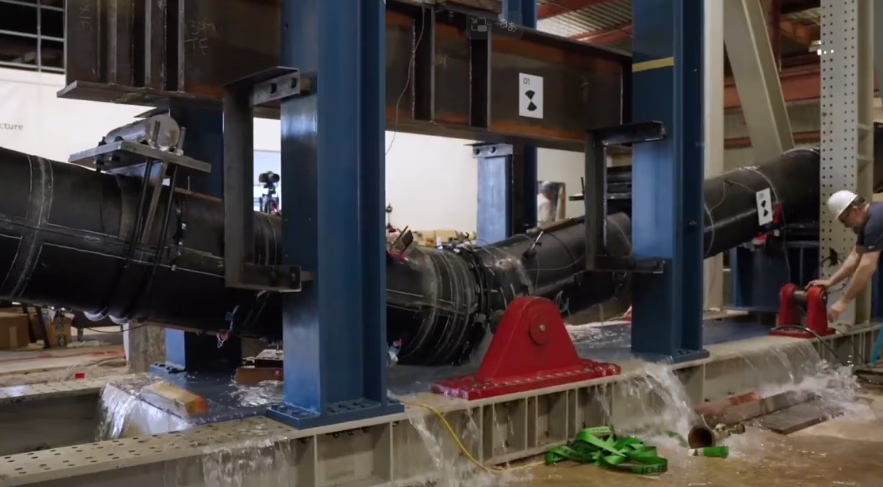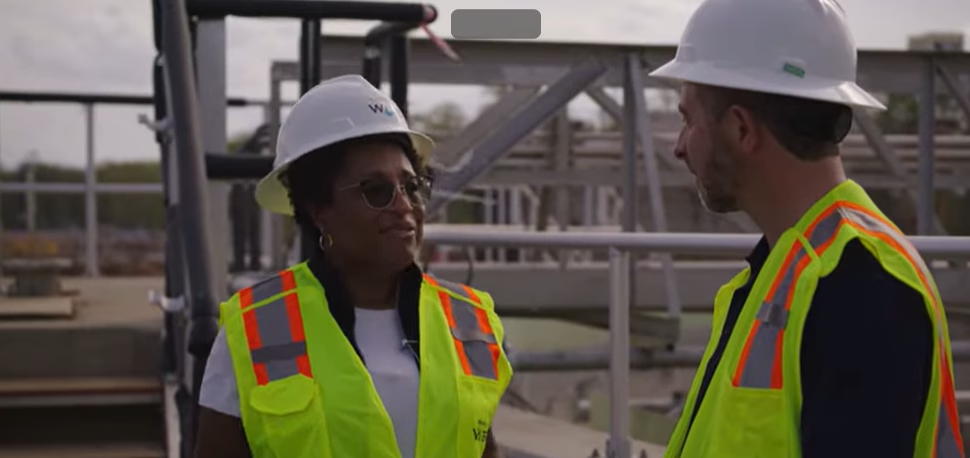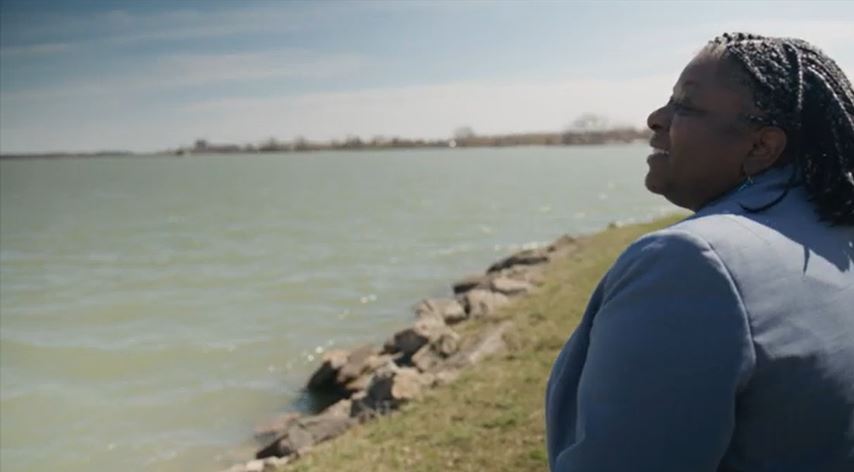Water 2050
AWWA’s Water 2050 initiative will shape a long-term vision of the future of water that will chart a course for a successful and sustainable water sector.


Water 2050 Vision
A secure, sustainable, affordable, resilient, and innovative water future for all, in which everyone in the water community is collectively responsible for the management and preservation of this vital resource.
A secure, | Water that is safe, available and of the highest quality for its intended use |
sustainable, | Embracing circularity to minimize waste, reduce our footprint and safeguarding water for future generations |
affordable, | Equitably priced water that is affordable and accessible to all |
resilient, | A versatile, adaptable water paradigm that is not easily impaired by or can quickly recover from adverse events |
and innovative | New solutions that create new ways of understanding water consumption, consumer needs and service delivery |
water future for all, in which | |
everyone in the water community | Water professionals, adjacent water-dependent sectors, government, businesses, communities and individuals |
is collectively responsible | Water is personal and everyone has a shared responsibility for its management and protection |
for the management and preservation of | Protection of water through a One Water governance approach |
this vital resource. | Water, of course! |
Water 2050 In Action
These videos showcase how water professionals across North America are driving timely, transformative progress toward the Water 2050 vision, showcasing bold innovation and collaboration that is shaping the future of water.

Metro Vancouver: From Wastewater Treatment to Renewable Fuel Pioneer
Metro Vancouver, which serves 2.8 million people, is pioneering the use of hydrothermal liquefaction to turn web biomass into low-carbon biofuels. The wastewater utility is transforming a biosolids challenge into a valuable resource — illustrating Water 2050’s call for solutions across sectors at the intersection of water, energy and climate.

Regional Collaboration: The Story of Central Iowa Water Works
In 2024, 12 Central Iowa agencies came together to form a regional water utility. Central Iowa Water Works’ regionalization demonstrates how communities can come together to strengthen governance, resilience and long-term sustainability for a region’s water supply — charting the forward-looking path envisioned in Water 2050.

Innovating Water Sustainability and Resilience at East Bay MUD
East Bay MUD was the first wastewater utility in the United States to generate more electricity than it uses on site and is on track to become a carob-free water utility by 2030. It is currently building a 4.5-megawatt solar project, pioneering earthquake-resilient pipes and collaborating with Berkeley Center for Smart Infrastructure.

One Water: Charlotte Water’s Integrated Approach to Water Quality and Sustainability
Charlotte Water is reimagining how to serve this vibrant and growing North Carolina community by breaking down silos and treating all water as one interconnected resource. In the past year, Charlotte Water has been working on 144 projects that integrate flood management, water quality improvement, and ecological restoration.
Water 2050 Strategic Priorities
Water 2050 has transitioned from a stage of exploration to implementation. Strategic Implementation Teams (SITs) are driving action across five priority areas. These teams, composed of volunteer experts and young professionals from within and outside the water community, are developing action plans and engaging partners to achieve our goals. To achieve our vision for a sustainable and resilient water future, Water 2050 is focusing on five Strategic Priorities that address the most critical challenges and opportunities facing the water sector.
These priorities guide the work of diverse Strategic Implementation Teams (SITs), which develop action plans and engage partners to create a thriving water future for all.
1. Sustainability & Resilience
- A sustainable and resilient water future will bring about a more robust, versatile and adaptable water community – with a water paradigm that is not easily impaired by environmental, technical, economic, political, or demographic externalities.
2. Innovation & Circular Economy
- Enabled by innovation and emerging technologies, the future of a one water approach will be built around a circular water economy in which each component produced through treatment processes (liquid, solid and energy) is leveraged as an intrinsic value stream, reducing waste throughout the water community’s footprint.
3. Finance & Affordability
- In our envisioned future, water will be viewed as a public good, and the water community will have a shared understanding of the value of water, beyond current-day cost-of-service terms. While we will recognize the true, full costs of water, it will not be an economic burden on low-income, disadvantaged communities.
4. One Water Governance
- In a One Water future, an integrated management and governance framework will enable the value of water to be governed such that its highest and best use is leveraged to better serve communities and preserve the entire ecosystem.
5. Equity, Access & Community Engagement
- In our envisioned future, communities will provide water to their citizens in fair and equitable ways, allowing affordable access for all. Everyone in the water community will have a shared sense of responsibility for water preservation and will be empowered to protect it for current and future generations.

Advertisement
Recorded Webinars
Water 2050: Strategic Planning for Resilient Water Resources – From Vision to Action
earn how Sonoma Water uses strategic planning, community collaboration, and transparent technology to ensure resilient water resources.
Access Recording
Water 2050: The Value of Regionalization or Consolidation of Water and Wastewater Services
Find out what it takes to successfully implement water and wastewater utility regionalization or consolidation and explore different opportunities or solutions available to support your efforts.
Access Recording
Water 2050: Securing Our Future in a Circular Water Economy
Experts will demystify the circular water economy, share real-world examples, and provide ways to implement circular principles.
Access Recording
Water 2050: Rethinking Reserves
Learn about resources and strategies to apply risk-aware and risk-savvy thinking to financial reserves in your own utility.
Access Recording
Water 2050: Strengthening Public Trust in Water
This webinar highlights stories from water providers across the United States who have built strategic relationships with the communities they serve. This is a conversation-based webinar, filled with examples, visuals, and research to show the impact of community engagement.
Access Recording


Hopes & Ideas About the Water Sector From 2023
The future of the water sector, and the future of global water, are in the capable hands of current and future water professionals. This video showcases 10 authors reading excerpts from their letters to water professionals in the year 2050.
These priorities guide the work of diverse Strategic Implementation Teams (SITs), which develop action plans and engage partners to create a thriving water future for all.
See All Water 2050 Videos
Advertisement
Water 2050’s Beginnings
Water 2050 is already expanding far beyond AWWA to become a broad movement toward a successful water future. From its infancy, the initiative was focused on:
Engaging in meaningful conversations. Throughout 2022 and 2023, thought leaders from within and outside the water sector gathered at intimate “think tanks” to examine the future of water through the prism of five key drivers: sustainability, technology, economics, social/demographics, and governance.
Capturing collective knowledge. AWWA issued reports on insights from each think tank and published additional guidance to support the water community in realizing the Water 2050 vision. Input was gathered also gathered from members, conference attendees, AWWA’s geographical sections and others.
Enlisting strategic partners. Collaboration among water utilities, service providers, academia, water-sector organizations, and non-traditional partners is essential. We are reaching beyond the water sector to engage corporate water users, nonprofit organizations and other stakeholder groups for fresh insights.
Fostering intergenerational responsibility. Today’s and tomorrow’s water professionals and leaders must work together to create a successful future. The voices of young and emerging professionals remain an integral part of the initiative.
Water 2050 Think Tank Reports



Water StoryMaps
Explore StoryMaps that contain real-life examples of projects, innovations, and strategies that inspired artistic renderings.
View Story Maps
Water 2050 News
AWWA Connections Articles
Interviews
Journal AWWA Articles
Water 2050: A vision for sustainability and resilience
Read More
Water 2050: The circular economy of carbon
Read Now
Water 2050: A vision for one water governance
Read Now
Mile High City welcomes water community to ACE25
Read Now
Texas water sustainability efforts gaining momentum
Read Now
Load More
Cheryl Porter’s vision for the future of water
Read More
Joe Jacangelo on The Water Entrepreneur Podcast
Read More
Updates on AWWA’s Water 2050
Read More
Cross-sector collaboration imagines the future of water, recommends economics-focused strategies
Read More
Waterloop: Envisioning Water In The Year 2050
Read More
Load More


